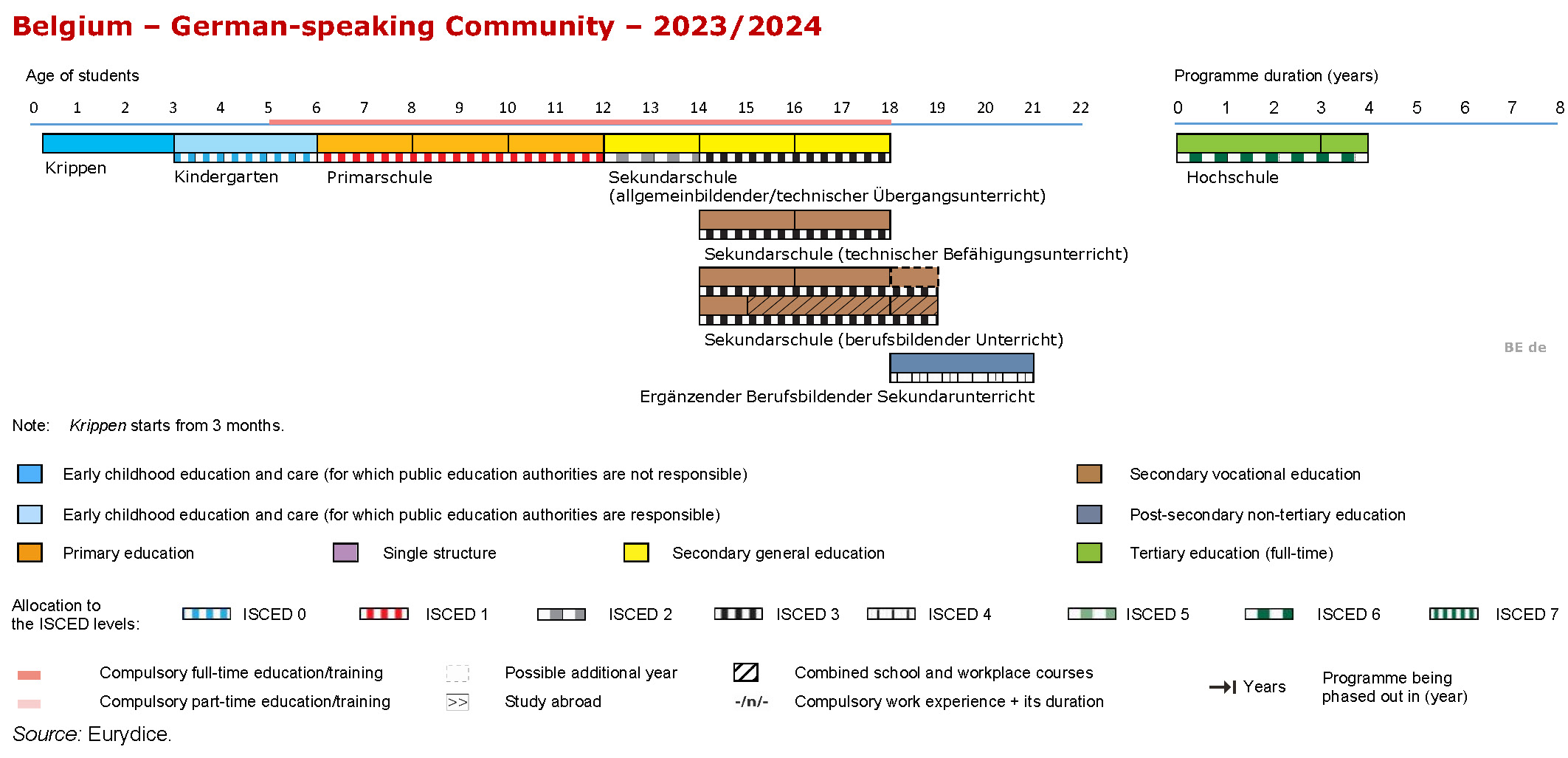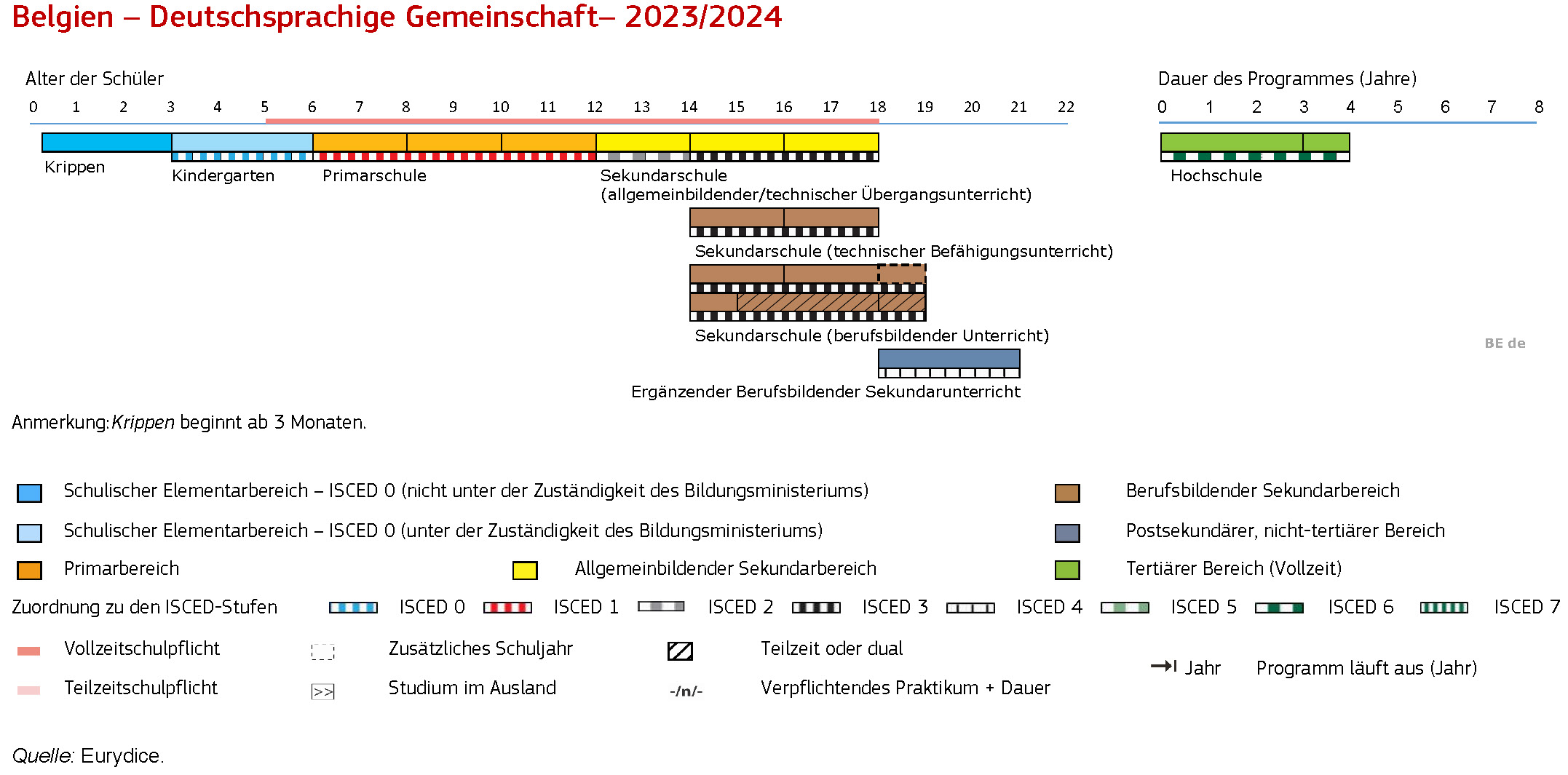Key features of the Education System
Educational competence
In Belgium, the three communities are responsible for education, with the following exceptions:
- the determination of the end and the beginning of compulsory school attendance,
- the minimum requirements for the issuing of diplomas,
- pension arrangements for teaching staff.
These three competences are in the hands of the federal state. In each community, teaching is offered in the language of the community. In the German-speaking Community, the Minister of Education is responsible for all levels from kindergarten onwards.
Freedom of education and school choice
Freedom of education is laid down in the Constitution of the Kingdom of Belgium: The establishment of schools must not be subject to any restrictive measures. It is therefore possible to set up schools which have no links with the public authorities. However, schools wishing to issue recognised diplomas and receive Community subsidies must be subject to the law.
The Constitution also guarantees a free choice of schools for parents. Parents and children must have access to a school of their choice at a reasonable distance from their place of residence.
Compulsory school attendance
Most children attend kindergarten from the age of 3 years. Compulsory education, however, begins at the age of 5, with admission to primary school. School attendance is required until 15-16 full-time and up to 18-part time. The classical way is that each student goes through three years in kindergarten, six years in primary school and six years in secondary school.
School networks
As in the rest of Belgium, the education system of the German-speaking Community distinguishes three school networks.
- The Community Education System (GUW) is the official education system organised and financed by the German-speaking Community.
- The Officially Subsidized Education System (OSUW) is organized by the municipalities and financed by the German-speaking Community.
- The Free Subsidized Education system is the system of schools organized by private school boards and financed by the community (mainly "Catholic" schools).
The Parliament of the German-speaking Community lays down the legal framework for all three school networks.
In the two networks, which are only financed by the German-speaking Community, the school authorities enjoy a large degree of autonomy, particularly with regard to teaching and evaluation methods.
The diplomas awarded by these networks are recognised in the same way as those awarded by the Community education system, on condition, however, that they comply with the framework laid down by the Community and the curricula in force.
Compulsory education
Most children attend kindergarten from the age of three.
However, compulsory schooling does not begin until the age of five, i.e. from the 3rd year of kindergarten. In the near future, children from the age of two and a half will also be able to attend kindergarten. Students are required to attend school until the end of the school year in which the student turns 15, full-time and part-time until the age of 18. Normally, each pupil goes through three years in kindergarten, six years in primary school and six years in secondary school (seven years for vocational education).
Educational levels in education
Primary education
In Belgium, the primary school is structured as follows: After kindergarten (three to six years), primary school follows (six to twelve years).
The kindergarten supports the varied education of children and stimulates their cognitive, motor and affective development.
The primary level is aimed at children between the ages of six and twelve and comprises six consecutive school years. After successfully completing primary school, pupils receive a certificate of completion of primary school.
Secondary level
In Belgium, secondary education is organised for young people aged 12 to 18 (for vocational education up to 19). Full-time education is compulsory up to the age of 15 to 16 (completion of lower secondary school).
Up to the age of 18, young people are required to attend school. For the upper level of secondary school, however, the young person may also choose part-time instruction. A young person is also required to attend part-time school if he or she concludes a recognised medium-sized apprenticeship contract, i.e. follows dual training.
School-based secondary education is divided administratively into three stages, each with two years. All pupils who have completed primary school attend the first stage together. For pupils without a primary school leaving certificate, there is the possibility of being enrolled in the first year of adaptation of the differentiated stage.
The common first stage, also known as the observation stage, covers the first two years of secondary education and aims to provide all pupils with a wide range of basic education.
The differentiated first stage comprises the first year of adaptation and the second year of vocational training and aims to provide targeted support for pupils who do not have a primary school leaving certificate.
In the second stage, also known as the orientation stage, and in the third stage, known as the determination stage, a distinction is made between general, technical and vocational education.
- General secondary education concentrates on a broad general education. It provides pupils with a solid basis for subsequent higher or university study.
- Technical secondary education pays particular attention to general and technical-theoretical subjects. After this secondary education, a young person may pursue a profession or pursue higher education. Secondary technical education shall also provide for varied work placements.
- Vocational secondary education is a form of practical training in which the young person receives general training but the main focus is on learning a particular occupation.
The special education system
If required, orientation into special education is possible from preschool age onwards:
A special school system is organised for children who need special support temporarily or permanently due to physical or mental disabilities, serious behavioural or emotional problems or severe learning difficulties.
Part-time teaching
If a student in Belgium is 15 or 16 years old, i.e. has completed lower secondary school, he can enter a system of alternating learning and working.
The young people who choose part-time schooling spend at least 28 hours a week in school or in an educational establishment. Part-time teaching is organised by part-time teaching centres. An alternative to part-time instruction at school is offered by the medium-sized apprenticeship contract, which combines company practice with attendance at a vocational school.
The higher education system
In the German-speaking Community, there is only a limited possibility to complete higher education studies. The Autonomous University, the only higher education institution in the German-speaking Community, offers the following courses:
- Educational sciences: Kindergarten
- Educational Sciences: Primary School
- Health and nursing sciences
- Financial and administrative sciences: Accounting
- Financial and administrative sciences: bank
- Finance and Administration: Insurance
- Finance and Administration: Public and Business Administration
In order to follow other courses of study, students must go to the interior of Belgium or abroad.
Lifelong learning
The German-speaking Community also offers various forms of education and training for adults.
Various courses are offered in the form of evening schools for adults. The offer includes language instruction, computer science, household courses and the certificate-oriented second chance education.
For more information, see the introductions to the article Structure and Control and the articles of all school levels: Early childhood care, education and upbringing, primary education, secondary education and post-secondary, non-tertiary, higher education and adult education.
To obtain information on other topics of the national system of education, read the introductions to the articles on education funding, teachers and other educational staff, management and other educational staff, quality assurance, pedagogical promotion and guidance, mobility and internationalisation.
For information on new or upcoming policy reforms, see Current Reforms and Policy Development.
In addition to the description on Drupal, which provides understandable and comparable information, additional information on the organisation of the school system in the German-speaking Community can be found on the Education Server of the German-speaking Community, designed by the Ministry. On the website DGstat, all statistical data are available.
Structure of the national education system


Common European Reference Tools Provided by the Eurydice Network
- National Student Fee and Support Systems
- Organisation of the Academic Year in Higher Education
- Organisation of School Time in Europe (Primary and general secondary education) Recommended Annual Instruction Time in Full-Time Compulsory Education in Europe (Presented by grades/stages for full time compulsory education as well as by subject and country.)
- Teachers and School Heads Salaries and Allowances in Europe (Salaries and allowances of teachers and school heads at pre-primary, primary, lower secondary and upper secondary education levels.)

